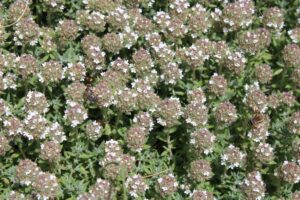How to Propagate Thymus baeticus

Thyme for a Little Propagation: Cultivating Your Own Spanish Thyme (Thymus baeticus)
Have you ever been captivated by the vibrant, sunny scent of Spanish thyme (Thymus baeticus)? This hardy Mediterranean herb, known for its lemony-citrus aroma and delicate, needle-like leaves, is a delightful addition to any garden or kitchen. And the best part? Propagating your own Spanish thyme is surprisingly easy!
Whether you want to expand your flourishing herb garden or share this fragrant treasure with friends, mastering the art of propagation is a rewarding journey. Here’s a guide on effectively multiplying your Spanish thyme, giving you a bountiful supply of this delicious and fragrant herb:
1. Seeds of Success: A Journey From Seed to Herb
- Collecting Seeds: Once your Spanish thyme plants bloom, tiny seed pods will appear. Harvest these pods before they fall to the ground, then let them dry thoroughly in a paper bag. Once dry, gently rub the pods between your fingers to release the seeds.
- Sowing Time: The optimal time to sow Spanish thyme seeds is in early spring or fall when temperatures are mild. You can directly sow seeds outdoors in a well-drained, sunny location. Alternatively, start seeds indoors in pots filled with seed-starting mix.
- Patience is Key: Spanish thyme seeds are tiny and require a warm, sunny location to germinate. Be patient, as germination can take several weeks. Once seedlings emerge, thin them to about 6 inches apart to promote healthy growth.
2. The Power of Cuttings: Easy and Quick Growth
For quicker results, propagation via cuttings is a popular method. Here’s how:
- Take Your Cuttings: Choose healthy stems from your Spanish thyme plant that are 4-6 inches long. Make the cut just below a node (the point on the stem where leaves grow).
- Prepare the Cuttings: Trim the lower leaves from the stem, leaving only a few at the top. Dip the cut end in rooting hormone powder to boost root development.
- Start Rooting: Plant the cuttings in a pot filled with a mixture of peat moss and perlite. Maintain a light, humid environment by covering the pot with a plastic dome or bag. Place the pot in a bright, indirect light location, away from direct sunlight.
- Success in 2 Weeks: Spanish thyme cuttings usually root in about two weeks. Check for new growth, which indicates successful rooting. Once roots have formed, you can slowly acclimate the cuttings to outdoor conditions before planting them in your garden.
3. Division: A Simple and Speedy Way to Multiply
- When to Divide: Divide your Spanish thyme plant in early spring or fall, after the plant has grown for at least a couple of years.
- Preparing for Division: Gently dig around the base of the plant and carefully lift it out of the ground. Gently separate the roots into smaller divisions, each with a healthy clump of foliage.
- Replanting the Divisions: Plant the divisions in well-drained soil, ensuring each division has adequate space to grow. Water them well and keep the soil consistently moist until they establish.
Tips for Success:
- Well-Drained Soil: Spanish thyme thrives in well-drained, sunny locations. Avoid planting in areas prone to excessive moisture.
- Regular Pruning: Regularly prune your Spanish thyme to encourage bushier, fuller growth.
- Enjoy the Harvest: Spanish thyme can be harvested throughout the year, ensuring you have a steady supply for cooking and crafting.
Embrace the Journey of Propagation
Propagation provides an exciting opportunity to expand your herb garden and share the joys of fresh herbs with loved ones. With patience, care, and the right techniques, you can cultivate your own flourishing patch of Spanish thyme, adding fragrant beauty and delicious flavor to your life. So, why not take a leap and embark on this rewarding propagation journey today?